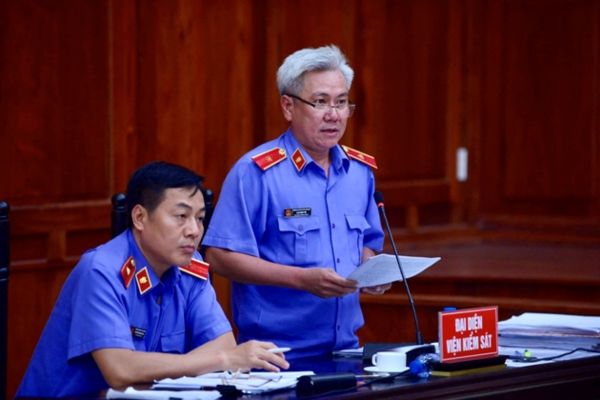How are the Outfits of the People's Procuracy Regulated? In What Cases Can a Procurator Wear Casual Attire?
How is the attire of the People's Procuracy regulated?
Based on the provisions of Article 4 of the Regulation issued together with Decision 54/QD-VKSTC-V9 of 2013 on the management and use of the attire of the People's Procuracy, identification cards, and legal title certificates in the Procuracy sector as follows:
Attire of the People's Procuracy
1. Regular attire includes: spring-summer pants and shirt; autumn-winter pants and shirt; cold-resistant coat; long-sleeved shirt; tie; belt; leather shoes; socks; sandals; raincoat; set of insignia, rank badges, name plate.
2. Ceremonial attire: summer ceremonial pants and shirt; winter ceremonial pants and shirt; long-sleeved winter ceremonial shirt; single pine branch set attached to the lapel of the ceremonial jacket; order ribbon (used on grand occasions), during holidays, conferences, and solemn meetings of the Communist Party, the State, and the Procuracy sector.
The attire of the People's Procuracy is divided into the following 02 groups:
- Regular attire includes: spring-summer pants and shirt; autumn-winter pants and shirt; cold-resistant coat; long-sleeved shirt; tie; belt; leather shoes; socks; sandals; raincoat; set of insignia, rank badges, name plate.
- Ceremonial attire: summer ceremonial pants and shirt; winter ceremonial pants and shirt; long-sleeved winter ceremonial shirt; single pine branch set attached to the lapel of the ceremonial jacket; order ribbon (used on grand occasions), during holidays, conferences, and solemn meetings of the Communist Party, the State, and the Procuracy sector.

How is the attire of the People's Procuracy regulated? In what cases are prosecutors allowed to wear civilian clothes? (Image from the Internet)
How is the regular attire of the People's Procuracy used?
According to the provisions of Article 6 of the Regulation issued together with Decision 54/QD-VKSTC-V9 of 2013:
Use of Regular Attire
Officials and public employees during working hours, when performing duties, attending meetings, and studying must use regular attire. To be specific:
1. In summer, wear spring-summer attire, attach insignia, rank badges, and name plate; in winter, wear autumn-winter attire, tie, attach insignia, rank badges, and name plate. The name plate is worn on the right chest, with the longer side of the name plate parallel and immediately above the pocket flap.
2. When wearing spring-summer attire, the shirt should be tucked into the pants if it is a shirt style; for blouse style, it should be worn outside the pants. No jewelry or decorative items that cause discomfort should be worn with the attire.
3. Officials and public employees at units from Thua Thien - Hue province onwards use seasonal attire; wear spring-summer attire from April 01 to October 31 annually, and wear autumn-winter attire from November 01 of the previous year to March 31 of the following year. Officials and public employees at units from Da Nang city onwards (except for Lam Dong province) wear regular spring-summer attire.
4. During the transitional period between summer and winter seasons or in localities with different weather conditions throughout the day, the use of autumn-winter or spring-summer attire is decided by the head of the agency or unit.
5. Officials and public employees wearing the prescribed attire must attach insignia combined with rank badges and wear helmets when traveling by motorbike or motorcycle.
Thus, officials and public employees at units from Da Nang city onwards (except for Lam Dong province) wear regular spring-summer attire.
As for officials and public employees at units from Thua Thien - Hue province onwards, the use of seasonal attire is as follows: wear spring-summer attire from April 01 to October 31 annually, and wear autumn-winter attire from November 01 of the previous year to March 31 of the following year.
In what cases are prosecutors allowed to wear civilian clothes?
Based on the provisions of Article 9 of the Regulation issued together with Decision 54/QD-VKSTC-V9 of 2013 on wearing civilian clothes as follows:
Wearing Civilian Clothes
1. Officials and public employees during working hours and when performing duties and attending meetings are allowed to wear civilian clothes in the following cases:
a) Due to work requirements or participation in cultural or social activities;
b) Female officials and public employees when pregnant from the 3rd month until 6 months after giving birth;
2. Wearing civilian clothes must be neat and polite according to the regulations of the Government of Vietnam on the attire of State officials and public employees.
Prosecutors are only allowed to wear civilian clothes in the following cases:
(i) Due to work requirements or participation in cultural or social activities;
(ii) Female officials and public employees when pregnant from the 3rd month until 6 months after giving birth.
Thus, during the performance of official duties, if it does not fall into the aforementioned cases, prosecutors are not allowed to wear civilian clothes. Violations of civilian clothes regulations will be handled in accordance with the regulations.
LawNet